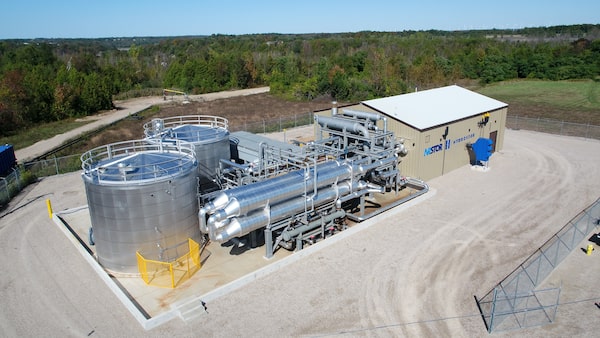
Hydrostor facility in Goderich, Ont.Hydrostor
Hydrostor Inc. has received $10-million from the federal government’s BDC Capital to advance four compressed-air energy storage projects it is looking to develop in Canada, the United States and Australia.
Hydrostor, whose technology allows utilities to add more wind and solar power onto their grids by smoothing out intermittent generation, is working toward final investment decisions for developments in Broken Hill, New South Wales, Australia; southern and central California; and Ontario. The money will be used for such items as engineering studies, permitting and community consultation.
“We got a lot of interest from BDC because they see us as technology champion to enable decarbonization of the energy markets,” said Guy Bentinck, Hydrostor’s chief financial officer.
“Long-duration energy storage is a growing challenge for grids worldwide, particularly in areas that we’re looking at – California and Australia, where they are probably a bit more advanced in deploying renewables and understanding where storage is a critical component.”
Financing from BDC’s investment arm follows $4-million in funding from Natural Resources Canada’s Energy Innovation Program and Sustainable Development Technology Canada in April, aimed at developing the 300 to 500 megawatt Ontario project. The company has not yet disclosed the location of that proposal.
Energy storage is becoming more prevalent as utilities around the world begin to phase out fossil-fuel generation and move to more renewables. Coal and gas-fired plants provide more predictable power but are major carbon emitters, contributing to climate change.
Hydrostor’s technology is an alternative to pumped hydro facilities and battery systems. The facilities can be located close to where the power is required, and do not need the elevated topography – or often difficult permitting – that pumped hydro does.
The system works by pumping compressed air into an underground cavern, which displaces water. The water rises into a reservoir at the surface. When the power is needed, the water is released back into the cavern, which pushes the air back out and drives turbines. Hydrostor has pilot and commercial demonstration plants operating on Toronto Island and in Goderich, Ont.
Hydrostor’s investors include the U.S. energy services company Baker Hughes Co., as well as Canoe Financial, ArcTern Ventures, MaRS Catalyst Fund, Lorem Partners and Elemental Energy Inc.
The 200 MW Australian project is expected to cost about $450-million, and the company is discussions on financiers and organization that provide clean-energy grant money, Mr. Bentinck said. The company expects to make a final investment decision around the middle of 2022.
“We’ve spent a decade or so developing this technology and demonstrating it, so as a consequence of that we have performance guarantees from third parties that basically support our process and will make the project financing a lot easier for something that’s scaling up into utilities,” he said.
Hydrostor is also looking to develop two projects in California, at 500 MW each, for a total investment of US$1.5-billion. French-based fund manager and infrastructure developer Meridiam has partnered with the company and has agreed to finance one of the projects, Mr. Bentinck said.
Your time is valuable. Have the Top Business Headlines newsletter conveniently delivered to your inbox in the morning or evening. Sign up today.
 Jeffrey Jones
Jeffrey Jones